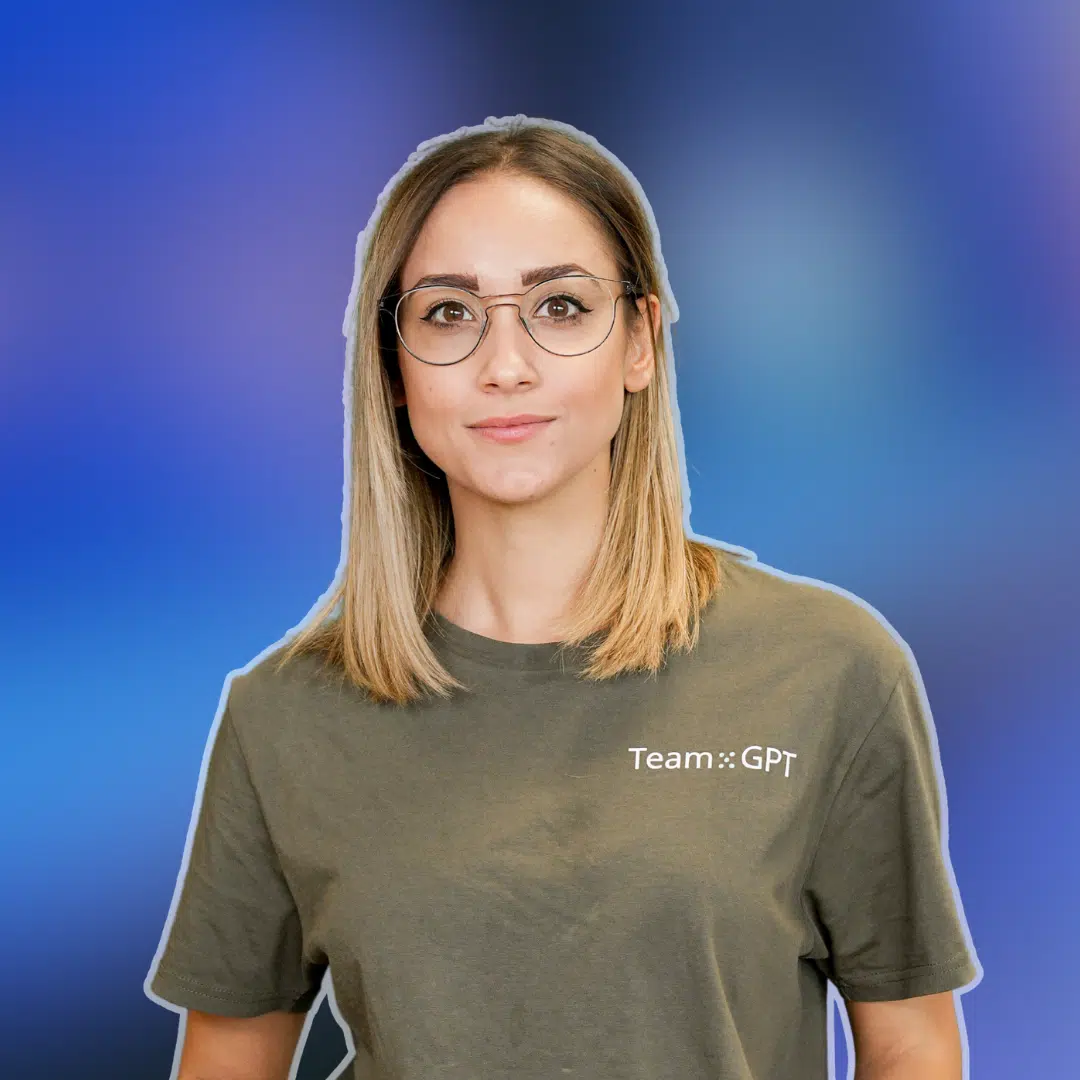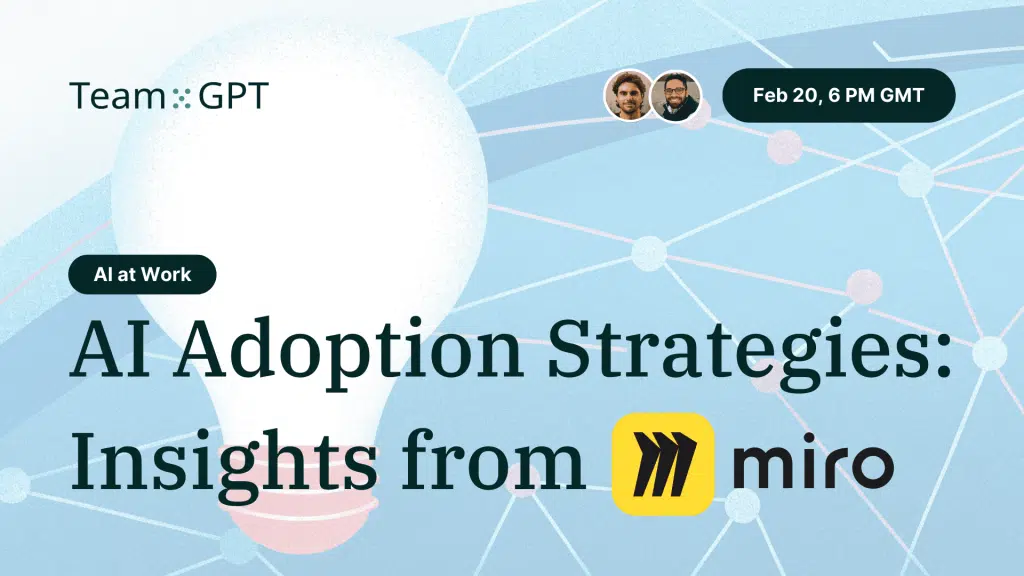In the first episode of Team-GPT’s “AI at Work” webinar series, Andre Nunes Pedro, VP of Revenue at Team-GPT, sat down with Nick Krekis, AI Program Manager at Miro, to explore how Miro is successfully implementing AI tools across their organization. Nick shared practical insights on AI implementation, including his ELEVATE framework and approaches to overcoming common challenges.
Top 5 Takeaways
- Start with Quick Wins
Focus on high-impact, low-effort initiatives to build momentum and demonstrate value early in your AI adoption strategy. - Quantify the Value
Assign dollar values to workflows to build compelling business cases for AI productivity tools and track ROI effectively. - Meet People Where They Are
Recognize different adoption personas and tailor your approach to each group’s readiness for AI workflow automation. - Process Mapping is Essential
Detailed workflow documentation creates the foundation for both business process improvement and future AI implementation. - Find and Empower Champions
Identify early adopters across departments who can inspire others and drive adoption of AI tools for business throughout the organization.
Nick’s Journey to AI Literacy
Nick’s transition from a recruitment background to leading AI initiatives at Miro highlights the importance of curiosity and continuous learning in the rapidly evolving landscape of AI productivity tools.
Nick shared two pivotal “aha moments” that transformed his understanding of AI workflow automation:
- Accelerated Learning Through AI: Using ChatGPT to create a personalized development plan for transitioning to program management, Nick experienced firsthand how AI productivity tools could compress learning curves.
- Prompt Engineering Skills: After taking a course in prompt engineering, Nick discovered how to scale his AI interactions and extract more valuable outputs, taking his capabilities “to a whole new level.”
He emphasized that behavior must precede skill development:
“It’s got to be a focus on the behavior before the skill so you need to understand why you’re doing it and what you need to show up as to do that.”
Miro’s AI Adoption Journey
As a $17 billion company at the forefront of innovation in the workspace sector, Miro recognized the strategic importance of embracing AI productivity tools early. Nick explained that the company’s AI adoption strategy is driven by:
- Market Opportunity: Recognizing the significant changes happening in technology
- Customer-Centric Innovation: Understanding that Miro’s customers are also navigating AI transformation
- Process Efficiency: Streamlining internal workflows to improve productivity through AI tools for business
Miro’s AI adoption strategy is structured around a central strategic programs team working with vertical-specific champions across departments. This hub-and-spoke model ensures both company-wide standards and department-specific customization for AI workflow automation.
Ensuring Employee Buy-In
To manage change effectively during AI implementation, Nick shared a memorable framework based on different adoption personas:
The five types of adopters in AI transformation include:
- Bell Wearers: The vocal leaders making noise about AI’s potential
- Alpha Cows: Early adopters who create momentum and embrace change
- The Majority: Those undecided but willing to follow once they see success
- The Dog Cows: Those comfortable with the status quo who need gentle nudging
- The Stick Cows: The vocal opponents who may actually have valuable insights about risks
Nick emphasized the importance of meeting people where they are on their AI journey and addressing concerns honestly:
“AI won’t replace you, but someone using AI will.”
This perspective helps teams understand the competitive necessity of AI adoption.
Measurable Wins: The Interview Note-Taking Case Study
When identifying opportunities for AI implementation, Nick applied an impact-versus-effort analysis to recruitment processes:
After evaluating CV screening, candidate sourcing, and interview note-taking, his team determined that automating interview notes with AI productivity tools offered the highest return on investment.
With Miro conducting 23,000 interview scorecards annually, each taking 15-20 minutes to complete, implementing AI tools for business is projected to save approximately $200,000 worth of employee time per year. This time savings allows interviewers to focus on higher-value activities while improving decision quality through business process improvement.
The ELEVATE Framework
The cornerstone of Nick’s approach to AI implementation is his ELEVATE framework, a four-step methodology for identifying, quantifying, and optimizing workflows:
The framework includes:
- Visualize Workflows: Create detailed process maps at three levels:
- Level 0: Core processes (e.g., recruitment pipeline)
- Level 1: Workflow layers within each process
- Level 2: Granular, step-by-step tasks performed by individuals
- Quantify Costs: Assign dollar values to workflows based on:
- Direct costs (active time spent on tasks)
- Indirect costs (related expenses)
- Opportunity costs (value of alternative activities)
- Identify Improvements: Determine specific optimizations for each workflow
- Measure Value Creation: Track value at three levels:
- Direct value (immediate time/cost savings)
- Indirect value (improved decision quality, time for innovation)
- System value (transformational change at scale)
The power of this approach lies in its compounding effect:
“When we start to make improvements on a really granular level in a lot of different places, that then starts to compound at scale.”
Future of AI at Miro
Looking ahead, Nick envisions the evolution of “agentic teams” at Miro – collections of specialized AI tools working together to solve complex problems:
As these systems mature, the focus will shift to optimizing the agents themselves for greater efficiency and cost-effectiveness.
This progression aligns with Miro’s goal of augmenting humans rather than replacing them:
“It’s taking away all of that admin stuff, whatever it might be, and bringing them up to be doing a lot more just brain-powered work.”
Quick Wins to Improve Your AI Transformation
For companies beginning their journey with AI productivity tools, Nick offered practical guidance:
Nick emphasized the importance of executive sponsorship and focusing on small, impactful initiatives before scaling your AI adoption strategy.
He noted that certain departments typically adopt AI tools for business more readily, including sales, marketing, recruiting, engineering, product, and design. These teams often deal with text-heavy processes or repetitive tasks that benefit immediately from business process improvement through AI workflow automation.
Putting Insights into Practice
As organizations navigate their implementation of AI productivity tools, Nick’s insights provide a valuable roadmap for success. By focusing on process visualization, value quantification, and strategic implementation, companies can achieve meaningful efficiency gains while positioning themselves for future innovation.
The key is balancing quick wins with long-term transformation, ensuring that AI productivity tools deliver immediate value while building toward more comprehensive business process improvement.
Take the Right Next Step with Team-GPT
Start a free trial today and see how our collaborative platform helps your team develop AI solutions that address your specific business challenges, creating measurable impact from day one.



